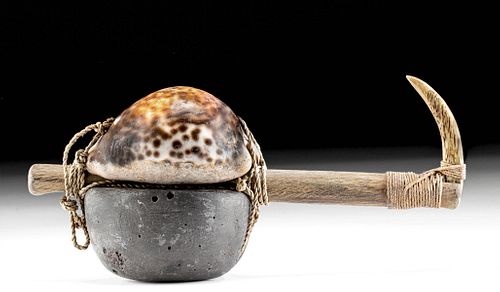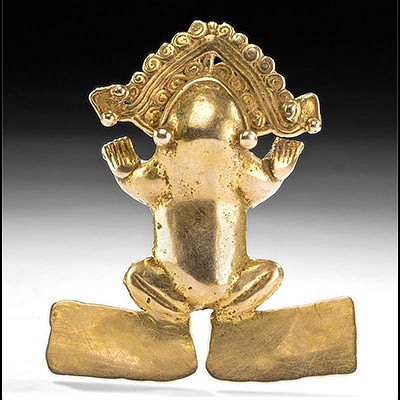Late 18th C. Hawaiian Stone, Shell & Bone Octopus Lure
Lot 115
About Seller
Artemis Gallery
686 S Taylor Ave, Ste 106
Louisville, CO 80027
United States
Selling antiquities, ancient and ethnographic art online since 1993, Artemis Gallery specializes in Classical Antiquities (Egyptian, Greek, Roman, Near Eastern), Asian, Pre-Columbian, African / Tribal / Oceanographic art. Our extensive inventory includes pottery, stone, metal, wood, glass and textil...Read more
Estimate:
$4,000 - $6,000
Absentee vs Live bid
Two ways to bid:
- Leave a max absentee bid and the platform will bid on your behalf up to your maximum bid during the live auction.
- Bid live during the auction and your bids will be submitted real-time to the auctioneer.
Bid Increments
| Price | Bid Increment |
|---|---|
| $0 | $25 |
| $300 | $50 |
| $1,000 | $100 |
| $2,000 | $250 |
| $5,000 | $500 |
| $10,000 | $1,000 |
| $20,000 | $2,500 |
| $50,000 | $5,000 |
| $100,000 | $10,000 |
| $200,000 | $20,000 |
About Auction
By Artemis Gallery
Aug 13, 2020
Set Reminder
2020-08-13 10:00:00
2020-08-13 10:00:00
America/New_York
Bidsquare
Bidsquare : Fine Antiquities, Ethnographic & Fine Art
https://www.bidsquare.com/auctions/artemis-gallery/fine-antiquities-ethnographic-fine-art-5415
Features classical antiquities, ancient and ethnographic art from cultures encompassing the globe. Egyptian, Greek, Roman, Etruscan, Near Eastern, Asian, Pre-Columbian, Native American, African / Tribal, Oceanic, Spanish Colonial, Russian, Fine Art, so much more! Artemis Gallery info@artemisgallery.com
Features classical antiquities, ancient and ethnographic art from cultures encompassing the globe. Egyptian, Greek, Roman, Etruscan, Near Eastern, Asian, Pre-Columbian, Native American, African / Tribal, Oceanic, Spanish Colonial, Russian, Fine Art, so much more! Artemis Gallery info@artemisgallery.com
- Lot Description
South Pacific, Hawaiian Islands, ca. late 18th to early 19th century CE. An early and exceedingly rare octopus or squid lure known locally as a leho he'e. The lure is composed of a central wooden rod, a large cowrie snail shell as well as a dark gray pumice stone bound with twisted sennet thread on one end, and a crescent-shaped hook fashioned from human bone on the opposite end. Octopus lures like this example were used by dipping the hook into shallow water and shaking it up and down in a rhythmic motion to entice an octopus to wrap its tentacles around the hook end. The fisherman would then rapidly pull the lure upward so as to pierce the creature's hard beak, soft body, or one of its many tentacles. A superb example of Hawaiian ingenuity! Size: 8.75" L x 3.9" W (22.2 cm x 9.9 cm)
For examples of Hawaiian octopus lures, please see The British Museum, museum number Oc1898,-.29, the Auckland War Memorial Museum (Tamaki Paenga Hira), accession number 11374, 5277, and the Cooper Hewitt Collection at The Smithsonian Design Museum, accession number 15.2012.43.
Provenance: private Whitestone, New York, USA collection, inherited in 1995 from father
All items legal to buy/sell under U.S. Statute covering cultural patrimony Code 2600, CHAPTER 14, and are guaranteed to be as described or your money back.
A Certificate of Authenticity will accompany all winning bids.
We ship worldwide and handle all shipping in-house for your convenience.
#156710Minor abrasions to stone, shell, wooden body, and bone hook, otherwise intact and near-choice. Wonderful patina and smooth surface textures throughout.Condition
- Shipping Info
-
All shipping is handled in-house for your convenience. Your invoice from Artemis Gallery will include shipping calculation instructions. If in doubt, please inquire BEFORE bidding for estimated shipping costs for individual items.
-
- Buyer's Premium



 EUR
EUR CAD
CAD AUD
AUD GBP
GBP MXN
MXN HKD
HKD CNY
CNY MYR
MYR SEK
SEK SGD
SGD CHF
CHF THB
THB
















